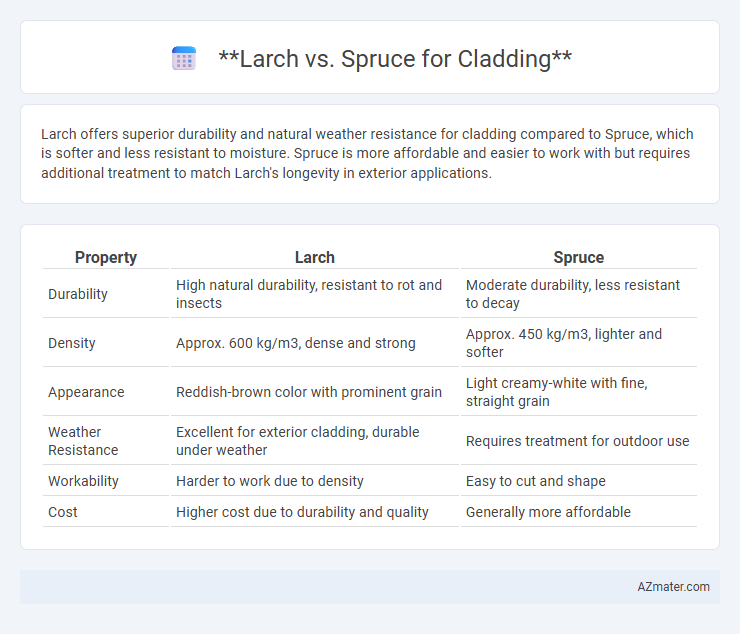Larch offers superior durability and natural weather resistance for cladding compared to Spruce, which is softer and less resistant to moisture. Spruce is more affordable and easier to work with but requires additional treatment to match Larch's longevity in exterior applications.
Table of Comparison
| Property | Larch | Spruce |
|---|---|---|
| Durability | High natural durability, resistant to rot and insects | Moderate durability, less resistant to decay |
| Density | Approx. 600 kg/m3, dense and strong | Approx. 450 kg/m3, lighter and softer |
| Appearance | Reddish-brown color with prominent grain | Light creamy-white with fine, straight grain |
| Weather Resistance | Excellent for exterior cladding, durable under weather | Requires treatment for outdoor use |
| Workability | Harder to work due to density | Easy to cut and shape |
| Cost | Higher cost due to durability and quality | Generally more affordable |
Introduction to Timber Cladding Options
Larch and spruce are popular timber cladding options known for durability and aesthetic appeal in exterior design. Larch offers natural resistance to decay and rich, warm tones, making it ideal for weather-exposed applications. Spruce provides a lighter color and smooth texture, often favored for its affordability and ease of finishing in timber facades.
Overview of Larch and Spruce Wood
Larch wood is renowned for its high durability and natural resistance to rot, making it an ideal choice for exterior cladding in harsh weather conditions. Spruce wood, while lighter and more affordable, offers good strength but requires proper treatment to enhance its weather resistance. Both woods present distinct grain patterns and textures, with larch exhibiting a tighter grain and richer color compared to the pale, uniform appearance of spruce.
Durability and Longevity Comparison
Larch wood offers superior durability and natural resistance to moisture and decay, making it highly suitable for cladding in harsh weather conditions. Spruce, while more affordable and easier to work with, generally has lower durability and requires regular maintenance or treatment to prevent rot and insect damage. Over time, larch cladding can maintain its structural integrity and appearance longer than spruce, resulting in reduced repair costs and enhanced longevity.
Weather Resistance and Performance
Larch wood offers superior weather resistance for cladding due to its dense grain and natural tannins that protect against rot and moisture. Spruce, while lighter and easier to work with, requires treatment to achieve comparable durability and weather performance. Larch cladding typically outperforms spruce in longevity and resilience in harsh weather conditions, making it a preferred choice for exterior applications.
Aesthetic Differences: Grain and Color
Larch cladding features a pronounced, coarse grain with warm golden to reddish-brown hues that deepen over time, creating a rich, natural aesthetic. Spruce cladding offers a finer, more consistent grain pattern with pale yellow to creamy white tones, providing a clean and uniform appearance. The distinct color and texture differences between larch and spruce allow designers to choose either a bold, textured look or a smooth, subtle finish for architectural cladding projects.
Maintenance Requirements for Cladding
Larch wood cladding demands less frequent maintenance due to its high natural durability and resistance to rot, reducing the need for regular treatments. Spruce cladding, while cost-effective, requires more consistent protective coatings and maintenance to prevent moisture damage and fungal decay. Proper sealing and annual inspections are essential for spruce to maintain its appearance and structural integrity over time.
Sustainability and Environmental Impact
Larch wood offers superior durability and natural resistance to decay, reducing the need for chemical treatments and extending cladding lifespan, making it a sustainable choice. Spruce, while more readily available and cost-effective, typically requires preservation treatments that can impact environmental health. Choosing Larch for cladding supports eco-friendly construction with lower maintenance and reduced chemical use, promoting a lower carbon footprint.
Cost Analysis: Larch vs Spruce
Larch cladding typically incurs higher upfront costs than spruce due to its greater density and durability, which reduces long-term maintenance expenses. Spruce is more affordable initially but may require more frequent treatments or replacements, increasing total lifecycle costs. Evaluating cost-effectiveness involves balancing Larch's premium price against its superior resistance to weather and decay compared to Spruce.
Installation Considerations and Ease
Larch offers superior durability and natural resistance to moisture, making it easier to install without extensive pre-treatment compared to Spruce, which often requires protective coatings to prevent decay. Larch's dense grain provides a sturdy surface that reduces the risk of warping during installation, whereas Spruce's softer texture can lead to faster wear on tools and potential damage. The stable dimensional properties of Larch ensure fewer adjustments and a smoother fitting process, while Spruce may need more frequent alignment checks and maintenance post-installation.
Best Cladding Choice: Larch or Spruce?
Larch wood offers superior durability and natural resistance to rot and insects, making it an excellent choice for cladding in harsh climates. Spruce, while more affordable and lighter in weight, lacks the same level of durability and requires additional treatment to withstand weather conditions. For long-lasting, low-maintenance cladding, larch is generally the best choice over spruce, especially in exposed or high-moisture environments.

Infographic: Larch vs Spruce for Cladding
 azmater.com
azmater.com